How To Soundproof a Door? {15 Proven Ways}

Soundproofing a door plays a crucial role in soundproofing a room. The door in a room is probably the biggest opening in a room and allows the majority of the sound to enter in your room.
Whether the noise coming from neighbors, street traffic, or noisy pets, I can confidently say that soundproofing your door can make a huge difference in creating a peaceful living space.
Because, I have done it with all the doors in my house and I am able to enjoy peace and quiet like never before.
So yeah, if you want to get your peace back and soundproof your door then stay till the end as I am going to tell you 15 effective and lesser-known ways to soundproof a door.
Keep reading…
15 Proven Ways to soundproof a door
1. Weatherstripping
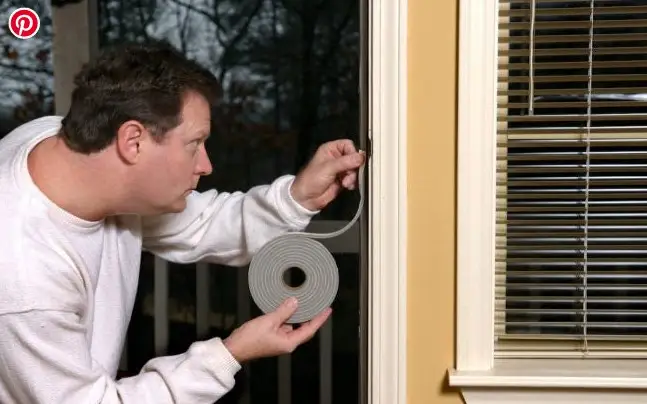
Weatherstripping is such a fantastic and budget-friendly material for soundproofing. Whether you are soundproofing an interior door or making a bathroom door soundproof, it can be used to reduce noise effectively.
If you are not familiar with it, weatherstripping is a material used to seal gaps to prevent the intrusion of air, water, dust, insects, and of course, sound.
This technique involves sealing up the gaps between your door and its frame, to stop pesky noises from getting in or out of the room.
Don’t worry, you don’t need to be a DIY expert to apply it – it is super doable. All you need to do is cut the weatherstripping to the size of your door frame sides, peel the backing from the tape, and stick it to the frame.
2. Install a door sweep
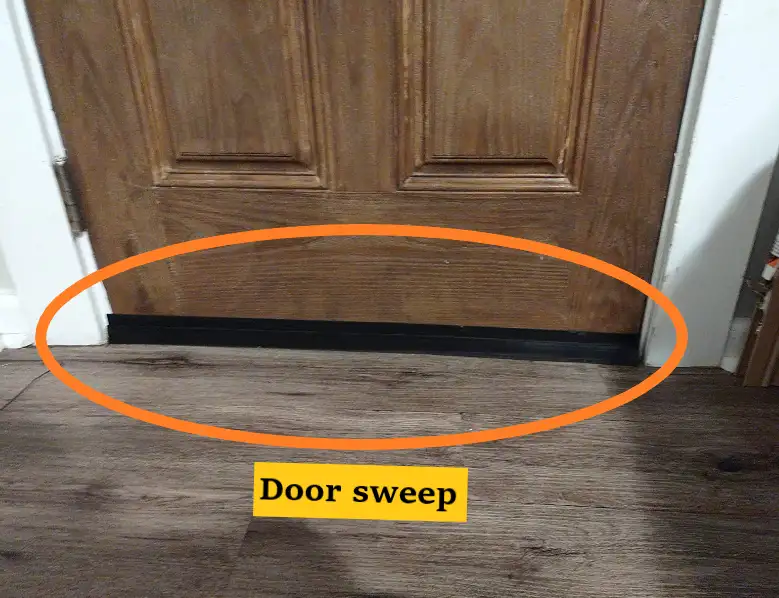
One effective soundproofing method for doors is installing a door sweep. A door sweep is attached to the bottom of the door to create a seal between the door and the floor to prevent drafts, as well as reduce noise from entering or escaping through the gap at the bottom of the door.
I have tested door sweep effectiveness and I found that It reduces the noise by 9 dB, so without a doubt door sweep is effective for louvered door noise-reduction or any door basically.
Installing door sweep is super easy just like installing weather-stripping tape.
To install a door sweep, take a measure of the width of your door and cut the sweep to size. Then, attach the sweep to the bottom of the door using screws or adhesive, just make sure that it is tightly secured and does not detach when opening or closing the door.
3. Seal gaps and cracks in your door using acoustic caulk
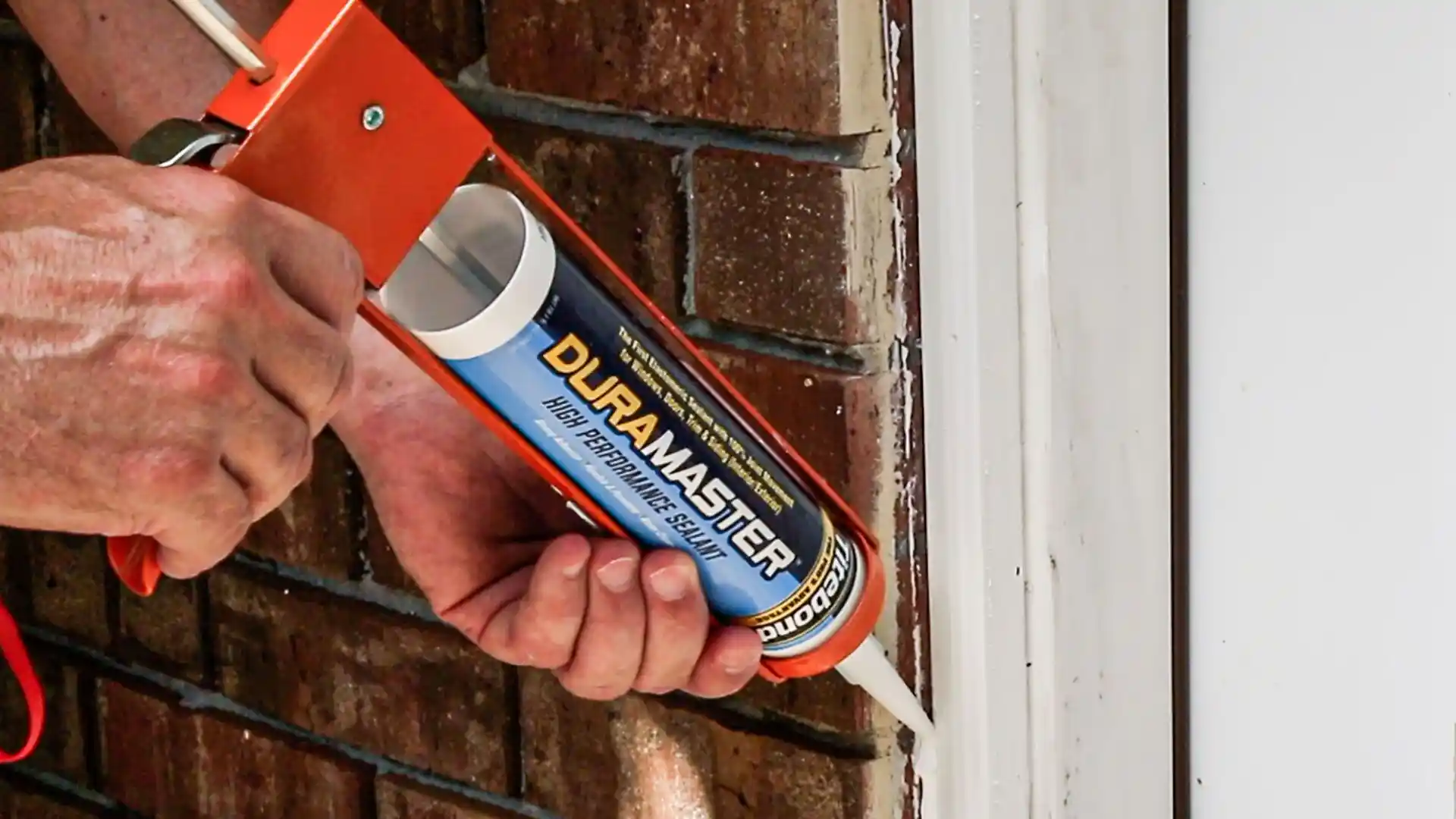
If you really want to effectively soundproof a door in your room sealing gaps and cracks is super important.
No matter whether you are soundproofing condo door or pocket door and how costly your soundproofing methods are they won’t work if there are gaps and cracks in your door. So, if you have cracks and gaps in your door, seal them as soon as possible. (Related: Pocket door noise-proofing techniques)
Anyway, there are four steps you need to take to seal those gaps-
- First of all, you need to identify them. Common areas to check include the door frame, the area between the door and frame, and any joints or seams.
- Next, load the acoustic caulk tube into a caulk gun.
- And, apply the acoustic caulk into the gaps and cracks you identified.
- Then use a putty knife or caulk smoothing tool to spread and smooth the caulk over the gap or crack. That’s it, you are done now.
4. Fill your hollow-door
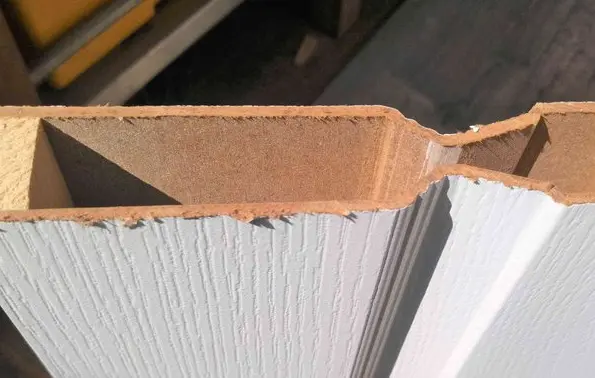
In my opinion, filling a hollow door is the most effective technique for soundproofing it. Hollow doors are often thin and lack the density needed to block out noise.
By filling the empty space inside the door with soundproofing material, you can increase its mass and reduce sound transmission to a great extent.
There are many options for filling a hollow door. One cost-effective and one that I would recommend is to use expanding foam insulation.
To fill your hollow core door with spray foam-
- Simply drill small holes into the door or cut the bottom of the door
- Insert the nozzle of the foam insulation canister
- And spray the foam into the door cavity. The foam will expand and fill the empty space, creating a denser barrier against sound.
Another option is to use MDF or Hardboard. Medium-density fiberboard (MDF) or hardboard are also great options for filling a hollow core door.
All you need to do is cut these materials to size and glue them to the door’s interior. They add weight and density to the door, helping to reduce noise infiltration.
Learn more: How to fill a hollow-core door?
5: Install a sound-absorbing curtain
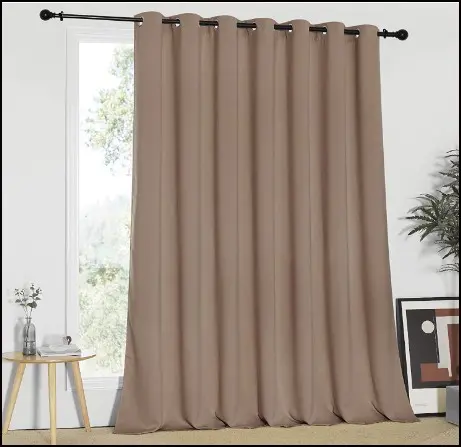
If you’re looking for a simple, effective and budget-friendly option for soundproofing a door, consider installing a sound-absorbing curtain. These curtains are made from materials that are engineered to absorb sound waves.
They are typically thicker and heavier than regular curtains, and often have multiple layers for better soundproofing.
To install a sound-absorbing curtain, buy a good quality sound-absorbing curtain for the door and hang it on a curtain rod just like you would with any other curtain.
Make sure the curtain is wide enough to cover the entire door and extends past the sides to minimize sound leakage. A good quality soundproof curtain can reduce the noise level by up to 29 db.
6: Install a soundproofing blankets
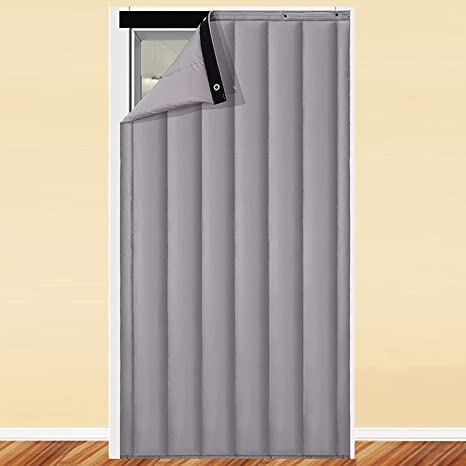
Installing soundproofing blankets is one of the popular options for soundproofing a door. Soundproof blankets are pretty much the same as the sound-absorbing curtain. These blankets are also designed to absorb and block sound.
They can be easily removed and repositioned as needed just like curtains. To install soundproofing blankets, you can either hang them over your door or attach them directly to the surface using hooks or adhesive strips.
7: Put Mass-loaded vinyl on your door
If you would ask me about the top 3 most effective soundproofing materials, one of my answers would definitely be mass-loaded vinyl (MLV). Its name speaks a lot about its soundproofing capabilities.
Mass-loaded vinyl (MLV) is a dense, flexible, and heavy vinyl sheet that contains materials such as barium sulfate or calcium carbonate to add mass and increase its sound-blocking capabilities.
Here’s how to use mass-loaded vinyl to soundproof a door:
Materials Needed:
- Mass-loaded vinyl sheet (available in rolls or sheets)
- Measuring tape
- Utility knife or scissors
- Adhesive (high-quality construction adhesive or MLV adhesive)
- Caulk or sealant (optional, for sealing edges)
Step-by-Step Guide:
- Prepare the MLV: First of all, measure and cut the mass-loaded vinyl sheet to the size of your door.
- Position the MLV: Next, place the MLV sheet over the door, ensuring it is centered and covers the entire surface. You can use tape to hold it in place or have a helping hand to assist you and prevent it from shifting while you staple it.
- Staple Placement: Start stapling from the top edge of the MLV sheet, then move to the sides, and finally to the bottom. Space the staples about 6 to 8 inches apart along the top edge. Make sure the staples are aligned parallel to the edge.
- Fill in the Middle: Once the edges are secured, continue stapling the MLV in the middle portion. Add staples as needed to ensure the entire sheet is firmly attached to the door.
Now, let me clarify one thing: using mass loaded vinyl (MLV) for soundproofing may not be aesthetically pleasing, especially if you have a fancy door.
In my experience, it works well for soundproofing doors that are fully made of wood, such as braced and framed doors.
8: Apply acoustic foam panels to the door
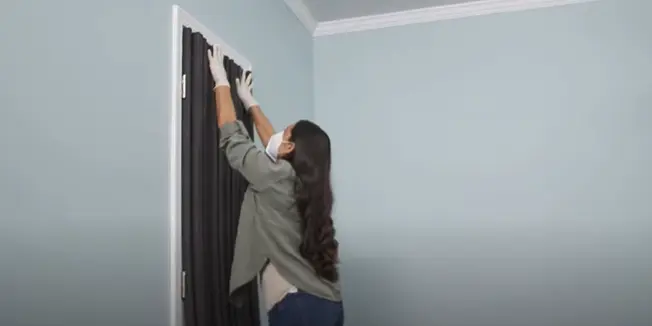
If you’re looking for a simple and affordable solution to soundproof a door, I would recommend using acoustic foam panels.
I am sure you have heard about it a ton of times. Acoustic foam is a sound-absorbing material designed to absorb sound and reduce their transmission. It is also effective at reducing reverberation.
That’s why it is commonly used in recording studios, home theaters, and noisy environments to improve sound quality and minimize the echo.
The effectiveness of acoustic foam panels depends on the thickness of the foam. Thicker and denser foam panels generally provide better sound absorption.
Here’s the 4-step process to applying acoustic foam panels to soundproof a door:
Materials Needed:
- Acoustic foam panels (with adhesive spray)
- Measuring tape
- Cutting tool (e.g., utility knife or scissors)
Instructions:
- Step 1: Measure the dimensions of the door to determine how many foam panels you’ll need.
- Step 2: Thoroughly clean the door surface to ensure it is free from dust, dirt, and debris. A clean surface will allow the adhesive to adhere better.
- Step 3: Now, spray the adhesive designed for foam materials on your door.
- Step 4: Carefully place the foam panels onto the door, starting from one edge and working your way across. Press firmly to ensure proper adhesion to the door surface.
9: Replace your hollow-core door with solid-core door
In my experience, replacing a hollow-core door with a solid-core door is one of the most effective way for soundproofing a hollow-core door.
Solid core doors have a denser construction, typically consisting of a solid wood or composite core covered with veneer or wood on the exterior. They are more effective at blocking sound and are more durable than hollow core doors.
Hollow core doors have a lightweight construction with a hollow interior, usually made of a wooden or composite frame with thin veneer panels on both sides. They are cost-effective but offer poor soundproofing and are less sturdy compared to solid core doors.
Studies have shown that solid core doors can reduce noise transmission by up to 50% more than hollow core doors. Its costs range from $75 to $250 or more, depending on the size of the door and quality of the material.
Now, you might be wondering, “Can I do it myself or do I need to seek help from a professional?”
So let me tell you that you can install a solid core door yourself if you have some DIY carpentry experience. In fact, I have done it myself too.
Step-by-Step Guide to Install a Solid Core Door:
Tools Required:
- Measuring tape
- Pencil
- Screwdriver
- Level
- Shims
- Drill
Materials Required:
- Solid core door
- Door hinges
- Door knob/lever
Instructions:
STEP 1: Measure the Door Opening:
Measure the width, height, and depth of the existing door frame. Purchase a solid core door that matches these dimensions.
STEP 2: Remove the Old Door:
Unscrew the hinges from the existing door frame and remove the old door carefully.
STEP 3: Prepare the Door Frame:
Inspect the door frame for any damages or irregularities. Repair or adjust as needed to ensure a level and even frame.
STEP 4: Prepare the New Door:
If needed, trim the new solid core door to fit the door frame using a wood plane or saw. Sand any rough edges.
STEP 5: Install the Hinges:
Position the door hinges on the side of the door where you want the hinges to be. Use a pencil to mark the screw holes, then pre-drill holes for the screws. Attach the hinges to the door using screws.
STEP 6: Install the Door Knob/Lever:
Follow the manufacturer’s instructions to install the door knob or lever on the door.
STEP 7: Install the Door:
With the help of a friend, hold the door in place within the door frame. Use shims to ensure the door is level and plumb. Insert the hinge pins into the hinges.
STEP 8: Check for Proper Fit:
Close and open the door several times to check for smooth operation.
STEP 9: Secure the Door:
Once you are satisfied with the door’s fit and operation, secure it in place by tightening the screws on the hinges and the door knob/lever.
10: Place a sound-deadening rug against the door
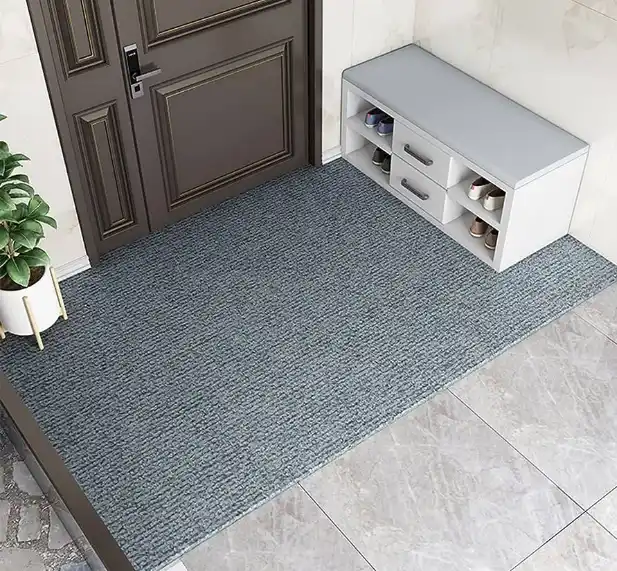
A sound-deadening rug is a thick and heavy rug or carpet designed to absorb and dampen sound. When placed against a door, it helps block noise from entering or leaving a room, contributing to soundproofing efforts.
While sound-deadening rugs can help with door soundproofing, they may not be as effective as other methods like curtains or blankets, especially for impact noise (footsteps, knocks).
They are more effective at reducing airborne noise. For impact noise reduction, additional soundproofing methods may be required.
By the way, the beauty of sound-deadening rugs is that they also help soundproof your floor along with the door and also reduces echoes in a room.
11: Install Door Handle Stopper
Installing a door handle stopper is a kind of hack for making a door quieter. A door handle stopper, also known as a door handle bumper or door handle silencer, is a small device designed to prevent a door handle or knob from hitting the wall when the door is opened forcefully.
When a door is swung open with force, the door handle can hit the adjacent wall, creating a loud noise that reverberates through the room. This impact noise can be bothersome, and it’s something we want to avoid.
By using a door handle stopper, you can prevent this from happening. It serves as a buffer between the door handle and the surface it might collide with, reducing impact noise and preventing damage to the door as well.
To use a door handle stopper to soundproof your door:
- First, choose a door handle stopper that you like.
- Next, look at where the doorknob hits the wall when you open the door. This is where you’ll put the door handle stopper.
- Now, stick or install the door handle stopper on that spot. If you have a big door or a door with more than one handle, I would recommend you use multiple stoppers to cover all the places where the doorknob might touch.
And you are done! The next time you open the door, you won’t notice that bothersome impact noise. If you don’t believe me, go ahead and open the door forcefully as you did before, and see the result.
12: Replace your existing door with a soundproof door
Replacing your existing door with a soundproof door is by far the most effective way to soundproof a door.
While this may be a more involved and costly solution, it can provide the ultimate soundproofing performance for your space. It is an excellent option if you are a podcaster, YouTuber, or do any type of work where sound quality matters the most.
Soundproof doors are specially designed to minimize sound transmission and are constructed with materials that absorb or block sound waves very effectively.
When choosing a soundproof door, there are several important factors to look for. However, in my opinion, the key factor to consider in a soundproof door is the STC rating.
The STC rating measures the door’s ability to block sound transmission. Look for a soundproof door with a higher STC rating, as it indicates better sound insulation.
Doors with STC ratings of 30 or above are considered effective at reducing sound, but I would suggest you choose one with an STC rating of at least 40 for optimal performance.
Other important factors to consider are Door Construction and Materials, Door Frame Compatibility, and Door Weight as well.
If you want to get a soundproof door for yourself visit the links:
- https://www.acousticalsurfaces.com/acoustic_doors/soundproof_doors.htm
- https://www.secondskinaudio.com/soundproofing/sound-lock-door
Related: How much do soundproof door cost?
13: Use Hinge Outlet Door Silencer
A Hinge Outlet Door Silencer, also known as a door hinge silencer, is a bit different from a door knob silencer. It is designed to reduce the noise generated when a door is closed.
Unlike the door knob silencer, which focuses on dampening the impact noise caused by the doorknob hitting the adjacent wall, the hinge silencer targets the noise produced when the door is closed forcefully and hits the door frame.
A hinge silencer typically consists of a small pad of rubber or foam material. It is placed between the door and the door frame, right at the point where the hinges come into contact during the door’s movement.
When the door is closed, the hinge silencer prevents the impact noise generated when the door hits the door frame.
Check this linked link to learn how to use it by watching the video.
14: Add additional wood panels to your door
Adding additional wood panels to a door to soundproof it is simple but effective DIY method to increase the mass the door, which helps to improve its soundproofing capabilities.
This technique is particularly useful for doors that are hollow or have thin construction, as it enhances the door’s ability to block sound transmission.
However, before I show you how to do it, let me first tell you that while adding additional wood panels can significantly improve the door’s soundproofing, it is important to consider the weight of the added panels.
Make sure that the door’s hinges and frame can handle the extra weight without sagging or causing other issues.
If you are sure that your door’s hinges and frame can handle the extra weight, then let me walk you through a step-by-step guide to do it.
Materials Needed:
- Wooden panels (plywood or MDF) of the desired size and thickness.
- Wood adhesive or construction adhesive.
- Screws or nails (optional, for extra reinforcement).
Step-by-Step guide to adding additional wood panels to a door:
- Measure the dimensions of the door’s surface that you want to cover with additional wood panels.
- Using a saw, cut the wooden panels to match the measured dimensions of the door.
- Apply wood adhesive or construction adhesive to the back of the wood panels.
- Press the wood panels firmly onto the door’s surface, aligning them with the edges.
- For added stability and durability, you can reinforce the wood panels with screws or nails. If you choose to do so, pre-drill pilot holes to avoid splitting the wood, then insert screws or nails at regular intervals around the perimeter of each panel.
- Let the adhesive dry for 24 hours. This allows the adhesive to cure properly for a strong bond.
- To ensure a complete seal and prevent sound leakage, use caulk to seal any gaps between the original door and the added wood panels.
- If desired, you can paint or apply a finish to the wood panels to match the door’s appearance.
15: Mask the external sound using a white noise machine
I’m sure you’ve probably heard about the white noise machine. It’s this device that produces a constant, soothing sound, covering a wide range of frequencies all at the same level of intensity.
The main purpose of this machine is to mask the external noises, and let me tell you, it’s pretty good at doing that.
If you want to try it out, you can go ahead and purchase a white noise machine that fits your needs.
Once you have it, just place it inside the room, ideally close to the door you want to soundproof and use it as you wish.
Soundproofing for Specific Door Types
Soundproof a Hollow Door:
1: Adding Mass:
In my perspective, one of the best ways to soundproof hollow doors is by adding mass to the door’s surface. You can achieve this by attaching a layer of mass-loaded vinyl (MLV) or adding additional wood panels.
MLV is a dense material that helps block sound transmission, while wood panels are also great. They help increase the mass and density of the door which contribute to better soundproofing.
2: Seal the Gaps:
Another important step in soundproofing hollow doors is sealing any gaps or cracks around the door’s edges.
You can use weatherstripping to seal the perimeter and for gaps I would recommend using expanding foam insulation or acoustic sealant to seal the gaps and cracks to prevent sound leakage.
Soundproof a Barn Door:
1: Acoustic Panels:
Installing acoustic panels on the barn door is a great way to soundproof it. Acoustic panels trap sound waves and prevent them from bouncing back into the space, thereby reducing the overall noise level.
I would strongly recommend you combine this technique with a sound-absorbing curtain to reduce the noise further.
2: Door Sweep and Threshold Seal:
Most of the Barn doors have larger gaps at the bottom, which allow sound to escape easily. Installing a door sweep and threshold seal will help seal these gaps effectively.
Door sweeps act as barriers, blocking sound from passing through the bottom of the door, while a threshold seal fills any gaps at the floor level.
Soundproof a Sliding Door:
1: Heavy Curtains:
Hanging heavy, acoustic curtains over the sliding doors can significantly reduce sound transmission.
In fact, I have used soundproof curtain to soundproof a sliding door in my room too. Their dense fabric works very well in absorbing and dampening sound waves.
2: Weatherstripping:
Like with hollow doors, using weatherstripping around the edges of sliding doors is essential and crucial. The weatherstripping creates a tight seal when the door is closed, preventing sound leakage through any gaps or the side.
Soundproof a Garage Door:
1: Garage Door Insulation Kit:
For soundproofing a garage door, install a garage door insulation kit, which typically consists of foam panels or reflective barriers.
These materials provide thermal insulation as well as soundproofing benefits, reducing the transfer of noise from the outside to the inside of the garage.
2: Lubricate the garage door mechanisms:
Select a high-quality silicone-based or lithium-based lubricant suitable for garage doors and apply it to all the moving parts. Focus on the rollers, hinges, tracks, springs, and any other points
Soundproof a Glass Door:
1: Double Glazing:
If you have a single-pane glass door then upgrading to a double-glazed or laminated glass can significantly improve soundproofing and it is by far the best way to soundproof a glass door.
2: Acoustic Caulk and Weatherstripping:
Applying acoustic caulk around the door frame and using weatherstripping will seal any gaps and cracks. This helps prevent sound leakage, making the glass door more soundproof.
Learn more:
FAQs: How to soundproof a door
1: How much will it cost to soundproof a door?
The cost of soundproofing a door can vary widely depending on the methods and materials you choose. Basic solutions like weatherstripping or door sweeps are super inexpensive, ranging from $10 to $50. More advanced options like installing soundproof blankets or mass-loaded vinyl can range from $100 to $500 or more per door. Replacing the door entirely can cost you $300 to up to $3,000.
2: Does putting a towel under the door work for noise?
Putting a towel under the door can provide some noise reduction by partially absorbing the sound from passing through the gap at the bottom of the door. However, towels are not designed specifically for soundproofing and may not be very effective in significantly reducing noise.
3: Are steel doors soundproof?
Yes, steel doors are soundproof, but not all of them are. It depends on the door’s construction and glass type. However, while steel doors can help reduce noise to some extent, they may not provide the same level of soundproofing as a solid core door.
4: Can I soundproof my door with spray foam?
Yes, you can soundproof your door with spray foam. It can provide some level of noise-reduction. Open-cell spray foam can help absorb sound waves and reduce noise, especially in gaps or cracks around the door frame.
5: Does soundproofing stop noise going out?
Soundproofing can significantly reduce the amount of noise that escapes from a room or space, but it may not completely stop all noise from going out.
Conclusion
Soundproofing a door doesn’t have to be complicated. It becomes super simple and achievable once you know what to do and how to do it.
In this post, I have outlined 15 methods for soundproofing a door. You can choose whichever is more suitable for your door type and budget.
In my opinion, weatherstripping, sealing gaps and cracks, filling your hollow door and installing mass-loaded vinyl are some of the most effective ways to noise-proof a door on a budget.
Fixing gaps and minimizing gaps is crucial; you should not overlook these at any cost. If there are gaps and cracks in your door, no matter how effective the methods you choose, they won’t work effectively.
Moreover, installing a door handle stopper, hinge outlet silencer and lubricating the hinge regularly can also make a significant difference in reducing noise if you open and close your door frequently.
And if you’re seeking the ultimate soundproofing solution, consider replacing your existing door with a soundproof one. So there you have it, the definitive guide for making a door quieter.
By implementing the techniques mentioned in this post, you can soundproof your door yourself.
Let me know in the comment: Which methods are you going to use for soundproofing your door?
